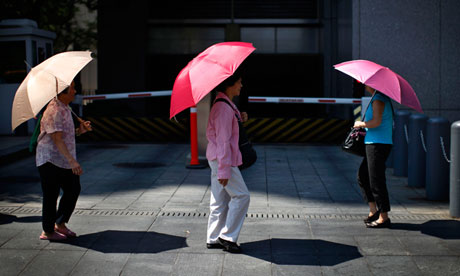
Women shield themselves from the midday sun with umbrellas during a New York heat wave. More frequent extreme heat due to global warming takes a toll. Photograph: Mike Segar/Reuters
I live in Minnesota, a northern state in the United States. While my state is generally known for bitterly cold winters, we also have our share of summer heat. While this past summer was not terribly hot, we still had stretches of very hot days. One of those stretches came late enough in the summer that schools were canceled – excessive heat was deemed too dangerous for children, teachers, and staff.
I must admit, I was surprised that it could get hot enough to cancel school, especially in Minnesota. What I can say is the temperatures were very hot and the school officials, in my mind, made the correct decision. For my day job, I study the impacts of heat on human bodies, so I was particularly interested in the closure. Research shows that human bodies are quite adaptive to weather changes. During very hot spells, our bodies alter blood circulation and perspiration to maintain healthy body core temperatures. But, there is a limit to our body's ability to resist heat, and as global temperatures rise, and periods of hot weather become hotter and longer lasting, our bodies will become stressed more often.
 Dr. Aaron Bernstein, Associate Director, Harvard Center for Health and Global Environment
Dr. Aaron Bernstein, Associate Director, Harvard Center for Health and Global EnvironmentDr. Aaron Bernstein from the Harvard School of Public Health, one of the world's experts in this area, expresses similar concerns. He stated,
"Extreme heat can be deadly, especially for people who are already vulnerable, such as the elderly, children, and people with diabetes. Higher temperatures can also increase ground level ozone which is toxic to our lungs and can make heat waves particularly dangerous for people with asthma and other chronic lung diseases. For children, ozone, which is a major asthma trigger, and heat-related dehydration, are particular concerns."
I asked him about our abilities to adapt to changing climates and he replied,
"In developed countries, we're seeing adaptation getting better and better. More air conditioning, more proactive warnings from authorities on extreme heat days to avoid the heat. In developing countries, the capacity to adapt may not be adequate. As a pediatrician, I wonder about how this country will deal with heat waves that force kids to stay inside and how this may play into our obesity epidemic. We want kids to be outside exercising but at the same time overweight and obese children are much more likely to have asthma and be kept indoors when it gets too hot out."
And of course, air conditioning is not always available. In my city, for example, installing air conditioning in all schools would cost an estimated $300 million. At a time when budgets are tight, such an expenditure is an impossibility.
Suffice it to say, increases in extreme heat, which includes both daytime and nighttime temperature levels, will pose challenges to our cities and infrastructure. Our bodies can usually handle short durations of high temperatures, but with extended heat that lasts days or weeks with no nighttime relief, it can become too much to bear.
For persons exposed to elevated temperatures, reactions can range from the mild (such as heat cramps, which are often effectively treated by rehydration) to more serious conditions such as heat exhaustion, which lead to reductions of blood flow to the body's extremities and may be accompanied with symptoms of dizziness, nausea, and low blood pressure, among others. People who exhibit these symptoms should be moved to a cool location and provided electrolyte rehydration.
Even more serious is heat stroke, which may arise with the same symptoms as exhaustion, but could ultimately lead to collapse, convulsions, and even death. Information on identifying and treating heat stress is available many places, including the Korey Stringer Institute, which is named in honor of the NFL football player, Korey Stringer, who died from heat stress during football practice in 2001.
My community is fortunate; we are blessed with proactive community leaders. When I brought my daughters to school on a recent hot day, I arrived to find the lights out, shades drawn, ample supplies of water for students and staff. Trained staff were constantly looking for evidence of heat stress. These small actions make a large impact in holding down temperatures and creating a safe learning environment.
The actions are guided by the vision of local leaders, such as the principal of our local school, Reinaldo Aponte. In reaction to the recent heat waves and ways his staff work to ensure the safety of schools, he says,
Safety of students and staff are always on my mind before, during and after school. I never imagined in my 28 years as a Minneapolis school employee and 19 years as a principal that we would be closed based on excessive heat in Minnesota. I wanted to be sure to keep the students hydrated, out of the sun, and in ventilated areas when possible. We reduce activities to minimize overexertion, encourage students to wear lightweight and loose fitting clothing when possible, and to communicate with families our safety tips.
I couldn't have said it better myself.







No comments:
Post a Comment